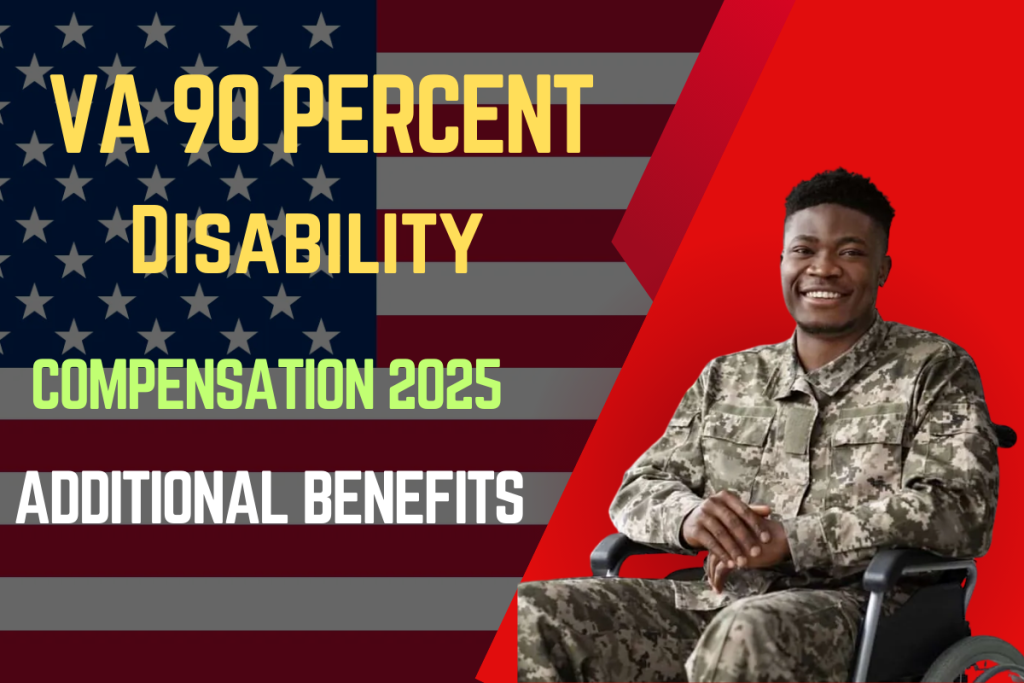VA 90 Percent Disability : In ten percent steps, the VA gives you a rating from 0% to 100% if your service-connected disability is real. This number is not just paperwork, this number is linked to your monthly compensation and a long list of benefits that can make your daily life easier. It doesn’t matter if you don’t have any dependents; once your VA disability rating hits 90%, you can get a lot of help.
A 90% rating is a big step, but understanding exactly what you get and what you might miss out on compared to higher ratings or veterans with dependents is confusing. Your questions about how much money goes into your account, what other help is available, or how to get to 100% will be answered clearly here.
VA 90 Percent Disability Overview
| VA Disability Rating | Monthly Compensation (No Dependents) | Key Benefits |
| 70% | $1,759.19 | VA health, home loans |
| 80% | $2,044.89 | Healthcare, rehab, loans |
| 90% | $2,297.96 | Priority health care, vocational rehab, home loans |
| 100% | $3,831.30 | Full benefits, highest support |
- 2025 rates reflect a 3.2% COLA increase
- Amounts are tax-free
- Dependents increase the monthly payment

How Much Compensation is Available for a 90% VA Disability Rating (No Dependents)
If you’re rated at 90% by the VA with no spouse, kids, or dependent parents, your base monthly tax-free compensation in 2025 is $2,297.96. This amount updated annually with the Cost of Living Adjustment (COLA) which is 3.2% for current year.
Factors that can change this amount include adding dependents—a spouse, child, or parent can mean a bigger monthly payment. But for a single veteran with no dependents, that $2,297.96 is a flat, reliable figure. If you will compared to 80% ($2,044.89) or 100% ($3,831.30), the increase to 90% is more.
Understanding the VA Disability Rating System
The VA uses a combined rating system. Each disability you’re rated for stacks up using a “percentage of the remaining healthy part” formula. Two 50% ratings won’t give you 100%, but around 75%. The ratings go up in exact 10% steps: every increment makes a difference, bumping your monthly payment. Hitting 90% puts you in the upper tier, but the leap to 100% is the biggest jump in both money and benefits.
A 90% rating means your service-connected disabilities are judged very severe but not quite at the “completely disabled” level. The process can feel frustrating, especially since the calculation is not obvious—many use online calculators to see where they land.
Monthly Compensation Details for 2025
The VA sets new disability pay amounts every year, usually starting in December. For 2025, the official monthly rate for a single veteran at 90% sits at $2,297.96. This is tax-free and unaffected by most other sources of income.
The VA includes COLA increases (for 2025 it’s 3.2%) so these payments keep up with inflation. If dependents come into play—such as a spouse, children, or parents—the base amount goes up. For example, a veteran at 90% with a spouse and 2 children under 18 they would get about $2,938.96 monthly. The rate is $2,297.96 for people who don’t have any dependents, though.
How Dependents Impact VA Disability Compensation
Dependents add extra to your payment. The VA pays more if you are supporting a spouse, a child, or sometimes even a parent. Each child under 18 adds about $95.33, and a spouse or parent provides a further increase. Might be if you are single with no dependents the you will receive the base rate. The difference can mean several hundred dollars a month, but the foundation is the same: all veterans at a certain percentage and family status get the same tax-free amount.
Additional Benefits and Programs for Veterans With a 90% Disability Rating
A 90% VA rating does more than just increase your monthly income. It opens the door to a range of programs, some of which you may not be using to their full potential.
- Health care priority group 1 status for top-tier VA medical care
- Eligible for VA home loan guarantees and housing grants
- Access to Vocational Rehabilitation and Employment
- Comprehensive education benefits
- Automatic eligibility for some state and federal programs
Health Care and Pharmacy Benefits
As a 90% rated veteran, you get placed in Priority Group 1 in the VA healthcare system. Your VA 90% Ratings means you will get extra benefit services like, outpatient visits, hospital stays, prescription drugs, and preventive care without paying any extra money. You can’t easily get this level of health care anywhere else besides the VA, and it can save your life when it comes to cost and accessibility.
Housing Loan and Vocational Support Guarantee Program
A VA rating at 90% makes you eligible for the VA Housing Loan Guarantee program. This allows you access to obtain payment mortgages without no private mortgage insurance (PMI). If your mobility or daily life at home is affected by disability, Then you can apply for Adaptive Housing Grants to help cover accessibility upgrades or even new housing.
Chapter 31, Veteran Readiness and Employment (VR&E) helps people find jobs. This program offers employment training, educational support, résumé aid, and even direct links to veteran-friendly employers. VR&E is an effective technique for changing occupations or adjusting to a new workplace.
How To Upgrade Your Rating From 90% to 100% or TDIU
Life changes, and so can your rating. If your condition worsens, you can submit new medical evidence and ask for a revaluation to jump to 100%. For some, this is a steep road, as the criteria get stricter.
If your disabilities keep you from working entirely, you may qualify for Total Disability based on Individual Unemployability (TDIU). This program pays you at the 100% rate even if your combined rating is 90%, as long as you meet certain requirements (like a single 60% disability or a combined 70% with one at 40%). TDIU is a lifeline for veterans who can not work due to service connected injuries.
A 90% VA disability rating with no dependents puts $2,297.96 in your bank account each month tax free and protected from inflation. But it also unlocks powerful benefits, including top-tier healthcare, home loan advantages, and job training support. If your health changes, or your household grows, you may increase your rating or payment. Don’t leave benefits on the table—use the evidence you have, keep records up to date, and reach out to a Veteran Service Organization (VSO) if you need backup. This rating is a big deal, and it’s worth making sure you get every dollar and service you’ve earned.
FAQs
How do I know if I qualify for TDIU with a 90% rating?
You may apply to TDIU when you are unable to maintain regular employment due to a condition that is connected to your military service and you have one disability that is rated at 60 percent or a combined 70 percent disability with one that is rated at 40 percent.
Is the VA 90 Percent Disability payment taxable?
No, all VA disability payments are tax free at both central and state levels.
What will happen if my disability gets worse?
You can file for a rating increase or additional benefits—collect updated medical records and submit them to the VA.


